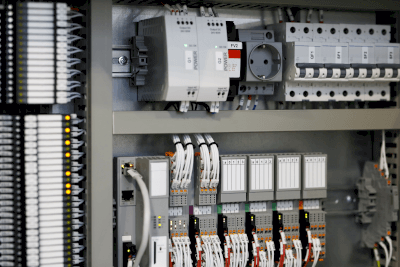What Is a Relay Terminal?
 A Relay Terminal is a terminal block to which a relay is attached.
A Relay Terminal is a terminal block to which a relay is attached.
In recent years, electronic precision devices such as logic controllers and industrial PCs have been used in the control operation part of industrial equipment. precision devices are steadily decreasing in size, while the output capacity of hardwired devices tends to be smaller. Therefore, when using instrumentation with large output capacity, such as solenoid valves and motorized valves, it is necessary to use relays to isolate them and increase their output capacity.
Relay Terminals make it possible to save space and easily isolate electronic precision components and instrumentation equipment with large output capacity.
Applications of Relay Terminals
Relay Terminals are used to control industrial equipment. In particular, they are often used to control large equipment. Examples include hydraulic presses, hydraulic conveying equipment, and filters for solid-liquid separation.
In the case of small industrial equipment, logic controllers and industrial PCs are not used. In most cases, control is done with hardware circuits using relays and the like. This is because electronic precision equipment is expensive. Relay Terminals are not often used in small devices because the main advantage of using Relay Terminals is to facilitate connection to a logic controller or similar device.
Principle of Relay Terminals
Relay Terminals are mainly divided into three parts: the relay part, the cable part, and the terminal block part.
The relay part isolates the output of precision equipment from the AC output, etc. The cable part isolates the AC output from the relay part. A relay is a device that uses an electromagnet to open and close the contact points used in an electric circuit. The output capacity can be increased according to the size of the relay. However, since the relay actually drives the contacts, contact roughness and other malfunctions can occur.
Currently, transistor outputs are the mainstream for logic controllers. This is because they do not have contacts and theoretically do not have a life span based on the number of times they are opened and closed. However, they can only be used in DC circuits and are mostly used at low voltages such as 24VDC.
Therefore, low-voltage coils such as 24 VDC are used for relays. Relays are removable from a single unit and can be easily replaced in case of failure.
Most cables are connectorized for easy connection to logic controllers, using 10 or more wires with a core diameter of 0.5 mm2 or smaller.
For the terminal block, a Phillips-head screw is used. Screw-in terminals are also used in some cases. Since most relays have a contact capacity of 5A or less, small terminals such as screws of 3.5M or less and screw-in terminals for wiring of 1.25mm2 or less in diameter are used.